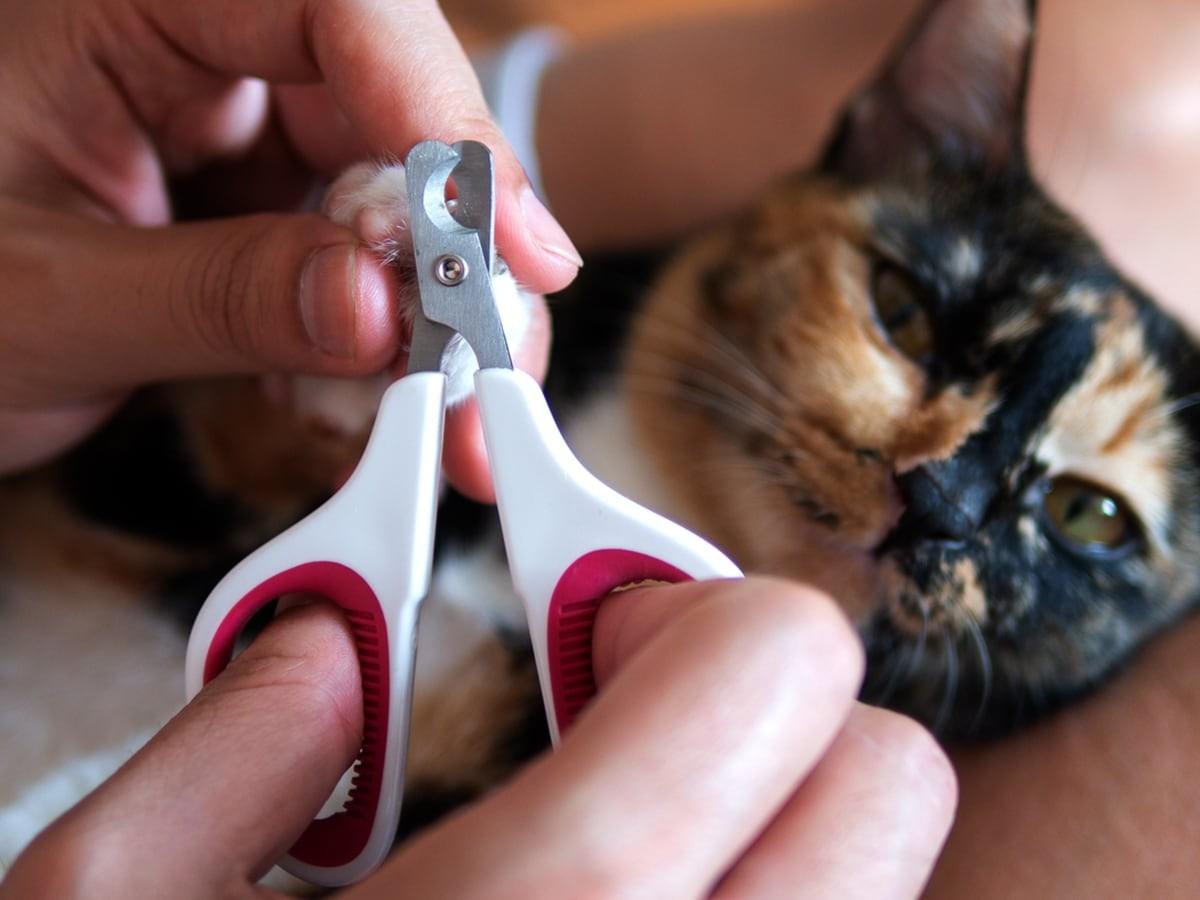If you’re a cat parent, one of your responsibilities is to regularly trim your cat’s nails (something that’s often easier said than done). No pet likes having their nails trimmed, whether cat or dog, so it can be tempting to put off this essential duty.
Trimming your cat’s nails might not be the most fun activity, but it is necessary. Claws that are too long can be uncomfortable and even painful for cats. Sometimes a scratching post can help reduce the length of a cat’s nails, but clipping will probably still be necessary.
If you’re looking for tips on how to clip your cat’s nails, you’ve come to the right place. We know that there are a lot of challenges that can come with being a pet parent, so we’re hoping that providing educational resources might help.
Being a good pet parent requires a lot of knowledge and dedication, but once you see that happy little face smiling up at you, it’s all worth it. So how can you accomplish one of the most difficult tasks: trimming your cat’s claws?
How often should I trim my cat’s nails?
It may not be fun, but pulling out the nail trimmers and putting an end to playtime is necessary. As the nails grow, they can cause more damage when your cat is kneading, and they’re much more uncomfortable for you when your cat decides to climb up your leg.
Another issue is that a cat’s claws are retractable, which means your cat can bring them back into their paws, but if they are too long, they stick out. Nails also curl as they grow, so if they are left uncut for a long period, they can curl into your cat’s paw pad. This causes discomfort and difficulty walking.
It’s usually best to trim the very tip of your cat’s nails every 10 to 14 days. You may have to take your time to get all of your kitty’s nails. It could take a few days, especially if your cat gets restless quickly.
You may notice your cat getting stuck in the carpet or other soft surfaces, which usually means it’s time for a trim.
Declawing your cat may seem tempting since you won’t have to deal with the nail trimming session every two weeks. However, declawing is generally considered bad for your cat. It can lead to behavioral problems and health issues.
How can I make my cat more comfortable?
When you are getting ready to clip your cat’s claws, it’s important to check they are comfortable with the process. Ideally, you’ll want to get your cat used to having their paws handled and their nails clipped from a young age.
Cats tend to object to people holding their paws. They may even dislike it even more than having their nails clipped. If you can, gently hold their paws from the time they are kittens so they can get used to it.
When clipping day comes, find a quiet place away from any distractions. It’s best to avoid windows, as your cat might find them too interesting to sit still. You’ll want somewhere that has a comfortable place to sit with your cat.
You should also try to catch your cat when they’re feeling sleepy and relaxed. Many cats will be very sleepy after they eat, so that might be a good time to try.
There are also many things that you can do in the days before your cat needs a clipping to help them to get used to it.
Preparing your cat for a nail clipping
Cats don’t like things that aren’t familiar to them, whether sounds, feelings, or instruments. So, before trimming your cat’s nails, get them used to the experiences associated with nail clipping.
First, you’ll want them to get used to having their paws handled and touched. Practice holding your cat’s paw. Gently rub it, and move with them when they move. After a few seconds, you can gently squeeze the toe so that a claw extends. You should give your kitty a treat afterward to encourage good behavior.
You should practice this a couple of times a day. It’s also a good idea to allow them to learn more about the clippers. You can leave them out near your cat so they can sniff around them. If you leave a treat on top, that might help.
You can help your cat get used to the sound by using the clippers to cut a dry spaghetti noodle as you rub their paw. The snap of the spaghetti and the clipper should make a similar sound to nail trimming. Then you should give your cat a treat so that they associate it with positive things.
How do I avoid hurting my cat?
We all care about cat care. That’s why when trimming your cat’s claws; you need to be careful. There is an area of their nails that has blood vessels and nerve endings, so if you cut into it, you can cause them some pain and bleeding.
This part of the nail is called the quick. Both cats and dogs have one, but they are easier to see in a cat’s claws because a cat’s claws are mostly clearish white. However, where the quick is, you should see a darker, slightly pink area where the nerve endings and blood vessels are.
If you aim the clippers to avoid this section, your cat should be fine, although it might be good to be prepared with some styptic powder or sticks.
When you use the clippers, they should always be cut from top to bottom (perpendicular to the paw) instead of on the side. If you cut the claw from the side, it will splinter and be crushed.
What kind of clippers can I use?
There are multiple types of cat nail clippers that are made to use on cats, so it may be difficult to choose. The best option for you and your cat might not be the best option for someone else. You should probably choose the option that you are most comfortable with.
A couple of choices are made specifically for trimming cat claws. You can pick a guillotine-like clipper, where there’s a hole that you place the claw into, and the blade slides up when you close the handles.
There are also specialized scissors designed to hold a cat’s claw in place while you trim it. If you want, you could also use human nail clippers.
Whichever tool you decide to use, it must be sharp. We all know how uncomfortable it can be if we can’t cut through our nails the first time. Cats are much more finicky and less likely to tolerate discomfort than we are.
A dull clipper might also cause your cat’s claw to splinter or bleed. You might also want to consider using a nail file to even out your cat’s claws if your kitty will sit still for that long.
How to trim cat nails
Here are some step-by-step instructions on how to trim your cat’s nails.
Secure your cat
There are many different ways you can hold your cat while trimming their nails. One method is to keep your forearms draped over their hind end and neck to keep them in place. You can also have them sit in your lap, facing away from you.
You could also ask another family member or friend to help you restrain your cat and offer them treats as you clip their nails. If need be, gently wrap them in a towel like a fluffy burrito.
Gently squeeze the paw
When trying to trim your cat’s nails, those retractable claws are probably retracted. To get them to extend, you’ll need to gently squeeze your cat’s paw around the toe. It’s best to use your forefinger and thumb, and you should try not to press too hard.
Position the clipper
No matter the clipper you use, it needs to be sharp to snip safely. When positioning it, make sure that you won’t be cutting into the quick. The clippers should be perpendicular to the paw to avoid causing your cat any pain.
Trim the nail
This step is probably the easiest since all you have to do is trim the nail. Only cut the white part; avoid the pink part of the nail (the quick).
Repeat
After you’ve gone through this series of steps, you can repeat steps two through five for each nail. However, you may not be able to get all ten (or more) claws in one go though. If they start to complain, you should just let them go and offer a treat for being good.
You can try again later. Just make sure you and your cat are in a good mood first. You should also check that you don’t miss any, especially the dew claw on the inner side of their feet. Dew claws don’t wear down with scratching, so they’ll become uncomfortable afterward.
What should I do if my cat’s nails start bleeding?
If you accidentally nick the quick or something else causes bleeding, there isn’t too much need for concern. You can use a styptic pencil or styptic powder to help stop the bleeding, although your cat may not like it too much.
If they complain and try to get away, you can let them go. The bleeding should stop after five minutes, but if it hasn’t stopped by then, it may be cause for concern, and you should call your cat’s vet.
Pet health is pet happiness
Clipping your cat’s claws may be difficult, but these tips should make your experience a little less stressful. By catching your cat in a good mood and making sure they are used to having their paws handled, it should be much easier to keep your cat’s claws at the right length.
To avoid accidental scratches or discomfort for your cat, you should probably trim your cat’s nails every ten days or so. Not only will it benefit your cat, but it will also benefit you and your furniture.
Cats normally don’t like being handled, but by holding them and their paws from an early age, and rewarding them with plenty of treats, you can help your cat get used to sitting still for at least a few trims. If you can’t cut your cats’ nails safely, you can always take them to the groomer or even your DVM for a vet tech to help cut nails.
Hopefully, these tips will help make nail trimming time a little easier for you and less stressful for your cat. If you are looking for other tips or tricks on how to care for your fur baby, you can check out our blog.

Creative manager by day, pet enthusiast all the time! After 19 years with my dog (hopefully he wins the award for oldest pet in the world), I enjoy spending my days brainstorming tail-wagging content, and sniffing out the latest trends in the pet world.
Cat Nail Clipping: How and When to Trim Your Cat’s Claws | WebMD
Clipping Your Cat’s Claws | Washington State University
How to cut cats’ nails | The Humane Society of the United States












